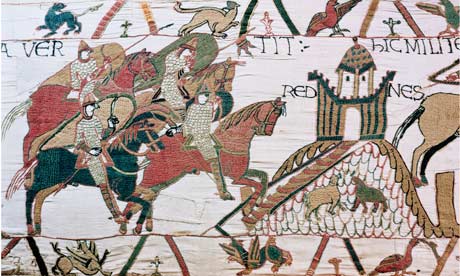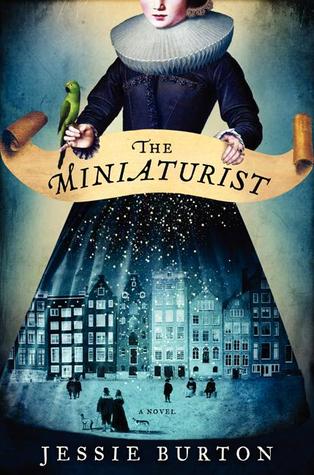In the aftermath of 1066 King William built castles to help secure his hold on England. Initially these were Motte and Bailey castles. On his arrival in England he put up a motte and bailey wooden castle at Hastings. The motte held the keep or tower. The bailey was the yard at the bottom of the man-made hill. This early castle can be seen on The Bayeux Tapestry. The castle erected at Hastings was simply a wooden tower constructed atop a man-made hill. Built within weeks of Duke William's arrival on England's south coast, it was as if Duke William had packaged it all up and carried it over the channel with him, like a building kit. There are other early castles shown on The Bayeux Tapestry. These were also constructed from wood. I used the castle at Bayeux in the early chapters of The Swan-Daughter.
I was fascinated by its flying bridge this castle possessed, over which horsemen could gallop into the Keep, the central tower. The bailey below the keep was filled with castle buildings such as stables, a hall, kitchens and herb gardens, pens for animals and so on. I use this concept in later chapters of The Swan-Daughter for the castle I imagined in Brittany by the sea in Ponthieu.
However there are several other real castles to be discovered in The Swan-Daughter. The first of these is Castle Dol where Count Alan, with whom Gunnhild, King Harold's daughter, elopes and where she overnights on her ride south into Brittany. Here, Alan and Gunnhild face danger from a Breton/English nobleman who challenged William of Normandy's authority and who left England for exile after his rebellion. The rebellion is known to history as The Rebellion of the Earls. It took place in 1075 and was the last real rebellion against King William's authority in England. No spoilers. You will have to read the novel so below I am placing a few free apple download codes to celebrate this book's publishing anniversary.
Castle Dol, shown above, was also a wooden castle and it, too, is shown on The Bayeux Tapestry. King Harold, then an Earl, saw it in an earlier time when he was in Normandy as William's guest and when he was involved in what was known as The Breton Campaign, illustrated on The Tapestry.
Wooden Castles were quick to build but they could burn to the ground. Already a stone keep existed in Falaise in Normandy and soon the Normans were building with stone in England also. These castles were more sophisticated. When the old Saxon palace in Exeter was pulled down, the castle erected there was known as Castle Rouge-mount. It was built with stone right against the old Roman walls.
Gunnhild and Count Alan eventually take up residence in England in Yorkshire. Much of the novel's action actually takes place in this castle. I try to imagine its keep as it might have been then. It was called Castle Richmond and if you visit NorthYorkshire it is possible to see the original keep. The castle is currently owned by British Heritage.
As centuries passed castles became much more sophisticated. The greatest era of castle-building was during the 13th century in the reign of Edward 1. Castle Richmond was improved, added onto, made stronger. It became much more fascinating and beautiful than it was in Gunnhild's time.
If you would like to read The Swan-Daughter for free on your ipad or phone here are codes. It is on a first come first served basis. The easiest way to download the book is to google ipad or apple gift downloads and follow the instructions. You will need to input your apple account number but no charge follows. the instructions are also on my face book page The Daughters of Hastings. Just 'like' the page.
Do download asap because once they are released these codes expire quickly though, of course, you can take time to read the book. Equally, The Swan-Daughter is available on amazon and as a paperback.
Happy Reading!
| Building the Castle at Hastings |
I was fascinated by its flying bridge this castle possessed, over which horsemen could gallop into the Keep, the central tower. The bailey below the keep was filled with castle buildings such as stables, a hall, kitchens and herb gardens, pens for animals and so on. I use this concept in later chapters of The Swan-Daughter for the castle I imagined in Brittany by the sea in Ponthieu.
 |
| Horsemen mount a bridge to the castle keep from the Bailey |
However there are several other real castles to be discovered in The Swan-Daughter. The first of these is Castle Dol where Count Alan, with whom Gunnhild, King Harold's daughter, elopes and where she overnights on her ride south into Brittany. Here, Alan and Gunnhild face danger from a Breton/English nobleman who challenged William of Normandy's authority and who left England for exile after his rebellion. The rebellion is known to history as The Rebellion of the Earls. It took place in 1075 and was the last real rebellion against King William's authority in England. No spoilers. You will have to read the novel so below I am placing a few free apple download codes to celebrate this book's publishing anniversary.
 |
| Castle Dol. See a flying bridge. |
Castle Dol, shown above, was also a wooden castle and it, too, is shown on The Bayeux Tapestry. King Harold, then an Earl, saw it in an earlier time when he was in Normandy as William's guest and when he was involved in what was known as The Breton Campaign, illustrated on The Tapestry.
Wooden Castles were quick to build but they could burn to the ground. Already a stone keep existed in Falaise in Normandy and soon the Normans were building with stone in England also. These castles were more sophisticated. When the old Saxon palace in Exeter was pulled down, the castle erected there was known as Castle Rouge-mount. It was built with stone right against the old Roman walls.
| Castle Richmond ( British Heritage) |
Gunnhild and Count Alan eventually take up residence in England in Yorkshire. Much of the novel's action actually takes place in this castle. I try to imagine its keep as it might have been then. It was called Castle Richmond and if you visit NorthYorkshire it is possible to see the original keep. The castle is currently owned by British Heritage.
As centuries passed castles became much more sophisticated. The greatest era of castle-building was during the 13th century in the reign of Edward 1. Castle Richmond was improved, added onto, made stronger. It became much more fascinating and beautiful than it was in Gunnhild's time.
If you would like to read The Swan-Daughter for free on your ipad or phone here are codes. It is on a first come first served basis. The easiest way to download the book is to google ipad or apple gift downloads and follow the instructions. You will need to input your apple account number but no charge follows. the instructions are also on my face book page The Daughters of Hastings. Just 'like' the page.
Do download asap because once they are released these codes expire quickly though, of course, you can take time to read the book. Equally, The Swan-Daughter is available on amazon and as a paperback.
Happy Reading!
J4AYWTP6FLLX
NKYNT7JNLHL7
XXTKMM3LX7PM
KFR94LX6N3W9

















































